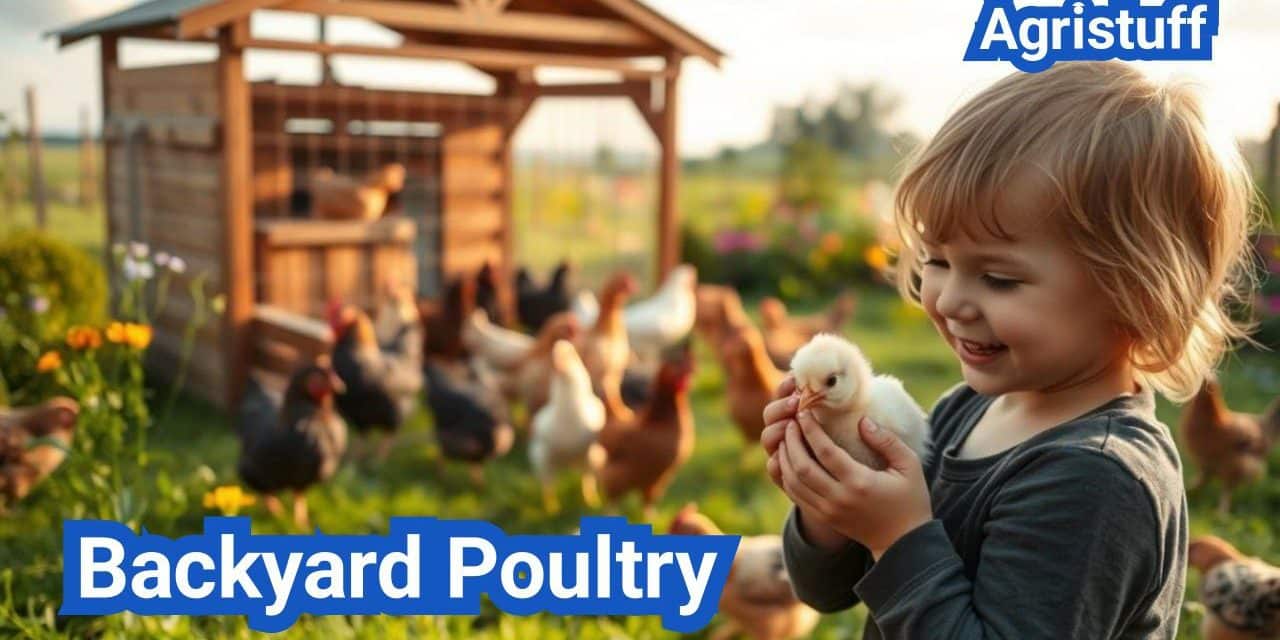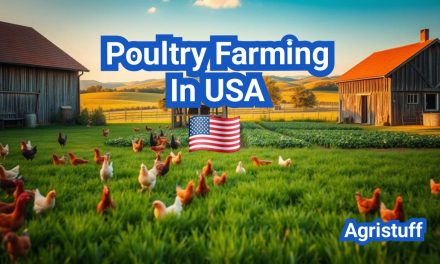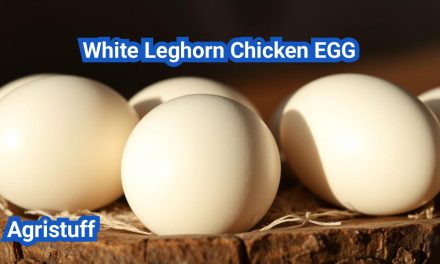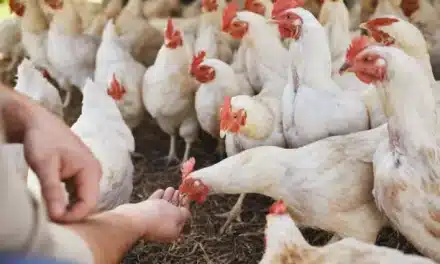For many homeowners, raising chickens at home is a rewarding experience that provides fresh eggs and entertainment. Small scale poultry keeping is becoming increasingly popular, especially among those interested in organic backyard poultry. To start, it’s essential to create a safe environment for your chicks, such as a brooder box, and ensure proper care and nutrition.
The concept of backyard poultry refers to the practice of keeping chickens and other birds in a residential setting. This practice not only provides a steady supply of fresh eggs but also offers the joy of keeping pets. Understanding poultry coop design and chicken health management is crucial for successful backyard poultry farming.
Key Takeaways
- Understand the basics of backyard poultry and its benefits.
- Learn how to create a safe environment for your chicks.
- Discover the importance of proper care and nutrition for chickens.
- Explore the concept of small scale poultry keeping.
- Understand the significance of poultry coop design and chicken health management.
The Basics of Backyard Poultry Farming
Backyard poultry farming is gaining popularity among homeowners looking for a sustainable and rewarding hobby. This practice involves raising chickens in your backyard for eggs, meat, or both, and it offers a unique opportunity to connect with nature and promote self-sufficiency.
What Backyard Poultry Means for Modern Homeowners
For modern homeowners, backyard poultry means having control over the food they consume and the ability to raise their chickens in a safe and healthy environment. It also represents a chance to teach children about responsibility and where their food comes from. Raising chickens can be a fun and educational experience for the whole family.
Benefits of Raising Your Own Chickens
Raising your own chickens comes with numerous benefits, including a steady supply of fresh eggs, a natural source of fertilizer for your garden, and pest control as chickens eat bugs and other small pests. Additionally, chickens can be a great source of entertainment and companionship. Many people find that keeping chickens reduces stress and promotes a sense of well-being.
- Fresh eggs daily
- Natural fertilizer for gardens
- Pest control
- Entertainment and companionship
- Educational for children
Common Misconceptions About Keeping Chickens
Despite its benefits, there are several misconceptions about keeping chickens that might deter people from starting their backyard poultry farm. One common myth is that chickens are noisy and will disturb the neighbors. However, most chicken breeds are relatively quiet, and with proper coop design, noise can be minimized. Another misconception is that keeping chickens is too much work or too expensive, but in reality, the initial investment can be minimal, and daily care is relatively simple.
By understanding the basics of backyard poultry farming, homeowners can make informed decisions about whether this practice is right for them. With the right knowledge and preparation, raising chickens can be a rewarding and enjoyable hobby.
Getting Started with Backyard Chickens

Before bringing home your first chickens, it’s essential to assess your backyard and local regulations. Starting a backyard chicken-keeping adventure requires careful planning to ensure a healthy and thriving flock.
Assessing Your Space and Resources
When assessing your space, consider the size of your yard and the amount of shade and sunlight it receives. Chickens need enough room to roam, so a general rule of thumb is to provide at least 2-4 square feet per chicken inside the coop and 8-10 square feet per chicken in the outdoor run.
Key considerations for your backyard:
- Available space for the coop and run
- Proximity to neighboring homes and potential noise disturbances
- Existing shelter or structures that can be repurposed
Understanding Local Laws and Regulations
Understanding local laws and regulations is crucial before starting your backyard chicken-keeping journey. Many cities and towns have specific ordinances governing the number of chickens you can keep, coop requirements, and whether roosters are allowed.
Check with your local government for:
- Permits or licenses required to keep chickens
- Restrictions on the number of chickens
- Specific coop and run requirements
Initial Investment and Ongoing Costs
The initial investment for backyard chickens includes the cost of the coop, run, chickens, and initial supplies. Ongoing costs include feed, veterinary care, and potential replacements for chickens.
| Item | Initial Cost | Ongoing Cost |
|---|---|---|
| Coop and Run | $500-$1000 | $0 |
| Chickens | $100-$300 | $0 (unless replacing) |
| Feed | $0 | $50-$100/month |
| Veterinary Care | $0 | $50-$100/year |
Timeline from Setup to First Eggs
The timeline from setting up your coop to collecting your first eggs can vary. Generally, it takes about 4-6 months from purchasing chicks to getting eggs.
Timeline:
- Setup coop and run: 1-4 weeks
- Purchase chicks: 1 day
- Raise chicks to pullets: 16-20 weeks
- First eggs: 18-24 weeks
Selecting the Right Chicken Breeds for Your Backyard
The key to a thriving backyard flock lies in selecting the appropriate chicken breed. With so many breeds available, each with its unique characteristics, it’s essential to consider several factors to ensure a harmonious and productive flock.
Best Egg-Laying Breeds for Beginners
For those new to backyard poultry, egg-laying breeds are a great starting point. Breeds like the Leghorn and Rhode Island Red are renowned for their high egg production. The Leghorn, for instance, can produce up to 300 large white eggs per year. These breeds are not only prolific layers but also relatively easy to care for, making them ideal for beginners.
Dual-Purpose Breeds for Eggs and Meat
Dual-purpose breeds offer the advantage of both egg production and a source of meat, making them a practical choice for many backyard poultry keepers. Breeds such as the Plymouth Rock and Wyandotte are excellent examples, providing a balance between egg-laying and meat production. These breeds are often hardy and adaptable, suiting a variety of backyard conditions.
Ornamental and Pet Chicken Varieties
For those who view their chickens more as pets or wish to add some visual appeal to their backyard, ornamental breeds are a wonderful option. Silkies, with their fluffy plumage, and Polish chickens, with their crested heads, are popular choices. These breeds may not be the most prolific layers, but they bring joy and diversity to the flock.
Climate Considerations for Breed Selection
The climate in your area plays a significant role in determining the most suitable chicken breed. For colder climates, breeds with thick feathering, such as the Brahma or Cochin, are well-suited due to their insulation properties. Conversely, in warmer climates, breeds with lighter plumage, like the Leghorn, can better tolerate the heat. Understanding your local climate will help you choose breeds that are more likely to thrive.
By considering these factors and breed characteristics, you can create a backyard flock that is both enjoyable and productive. Whether your focus is on egg production, meat, or simply the pleasure of keeping chickens, there’s a breed out there that’s right for you.
Essential Equipment for Raising Chickens at Home

To keep your backyard chickens healthy and happy, you’ll need to invest in some essential equipment. The right supplies not only ensure the well-being of your flock but also make managing your backyard poultry venture more efficient.
Basic Supplies Checklist
Before bringing home your chickens, it’s crucial to have the basic supplies ready. These include a safe and secure coop, feeders, waterers, nesting boxes, and roosts. A basic supplies checklist should also cover fencing materials for the run, a feeding trough, and a reliable source of chicken feed.
Feeders and Waterers
Feeders and waterers are critical for the health and nutrition of your chickens. Feeders should be designed to minimize waste and keep the feed clean and dry. Waterers should provide a constant supply of fresh water, protected from freezing temperatures in colder climates. There are various types of feeders and waterers available, including automatic models that can simplify daily care.
Nesting Boxes and Roosts
Nesting boxes provide a safe and comfortable place for hens to lay their eggs. It’s recommended to have one nesting box per 3-4 hens. Nesting boxes should be well-ventilated, easy to clean, and protected from predators. Roosts, on the other hand, are where chickens will perch at night. They should be sturdy, elevated from the floor, and designed to accommodate the size and number of your chickens.
Predator Protection Equipment
Protecting your flock from predators is a top priority. This includes using hardware cloth instead of chicken wire for the coop and run, as it provides better security against raccoons, foxes, and other predators. Electric fencing can also be an effective deterrent. Additionally, ensuring that the coop is secure and locked at night can prevent nocturnal predators from gaining access to your chickens.
Designing and Building the Perfect Chicken Coop
A well-designed chicken coop is the cornerstone of a successful backyard poultry-keeping experience. It not only provides a safe haven for your chickens but also plays a crucial role in their health, happiness, and productivity.
Space Requirements Per Chicken
One of the critical factors in designing a chicken coop is ensuring it provides enough space for your chickens. The general rule of thumb is to provide at least 3-4 square feet of space per chicken inside the coop. However, this can vary depending on the breed and size of your chickens.
| Chicken Breed | Space Requirement (sq ft) |
|---|---|
| Lightweight Breeds (e.g., Leghorns) | 2-3 |
| Medium Breeds (e.g., Plymouth Rock) | 3-4 |
| Heavyweight Breeds (e.g., Orpingtons) | 4-5 |
Essential Coop Features
Besides adequate space, there are several essential features to include in your chicken coop design. These include:
- Nesting boxes: one per 3-4 hens
- Roosting bars: enough space for all chickens to roost comfortably
- Ventilation: adequate windows or vents to ensure airflow
- Easy cleaning: a design that allows for simple manure removal
As Tom Smith, a seasoned poultry keeper, notes, “A well-ventilated coop is crucial for maintaining the health of your flock. Poor ventilation can lead to respiratory issues and other health problems.”
“The coop is the heart of your backyard poultry operation. Invest time and thought into its design, and you’ll reap the rewards in the health and productivity of your flock.”
DIY Coop Plans vs. Pre-Made Kits
When it comes to building your chicken coop, you have two primary options: DIY plans or pre-made kits. Both have their advantages and disadvantages.
| Feature | DIY Plans | Pre-Made Kits |
|---|---|---|
| Cost | Generally more cost-effective | Can be more expensive |
| Customization | Highly customizable | Limited customization options |
| Time and Effort | Requires significant time and labor | Quicker to assemble |
Ventilation, Insulation, and Weather Protection
Ventilation, insulation, and weather protection are critical aspects of chicken coop design. Proper ventilation helps remove moisture and ammonia from the coop, while insulation keeps the coop warm in the winter and cool in the summer.
Ensuring your coop is well-protected from the elements is also vital. This includes using waterproof materials for the roof and ensuring that the coop is securely fastened to prevent damage from wind or rain.
By carefully considering these factors and incorporating them into your coop design, you can create a safe, healthy, and productive environment for your chickens.
Creating a Safe Run and Free-Range Area

Ensuring your chickens have a safe and stimulating environment is key to successful backyard poultry keeping. A well-designed run and free-range area not only protect your chickens from predators but also provide them with the freedom to engage in natural behaviors, which is crucial for their overall health and happiness.
Fencing Options and Requirements
The fencing for your chicken run is a critical component that ensures their safety. When selecting fencing, consider materials that are durable and resistant to predators, such as hardware cloth or chicken wire with openings of about 1 inch. The fence should be at least 6 feet tall to prevent flying over and extend at least 12 inches below ground to prevent burrowing.
Key considerations for fencing include:
- Durability and resistance to weather and predators
- Adequate height to prevent escape
- Depth to prevent burrowing
Balancing Safety and Freedom
While safety is paramount, it’s also important to give your chickens the freedom to roam and engage in natural behaviors. Supervised free-ranging can be a great way to provide exercise and mental stimulation. However, it’s crucial to be aware of potential risks such as predators, toxic substances, and traffic.
“Free-ranging can significantly improve the health and happiness of your chickens, but it requires careful planning and supervision to ensure their safety.”
Enrichment Features for Happy Chickens
Enriching your chickens’ environment can significantly enhance their well-being. This can be achieved by adding features such as dust baths, perches, and foraging toys. These elements not only keep your chickens entertained but also encourage natural behaviors.
Some ideas for enrichment include:
- Creating a dust bath area with dry soil or sand
- Installing perches of varying heights
- Providing foraging toys filled with treats
Managing Free-Range Chickens in Limited Space
For those with limited space, managing free-range chickens requires creativity. Using portable coops or fenced runs that can be moved to different areas of the yard can help manage the space and provide your chickens with fresh ground to forage.
Tips for limited spaces:
- Use portable or movable fencing
- Rotate the run area regularly
- Consider vertical space with elevated runs
Bringing Home Your First Chickens

Bringing home your first chickens can be a thrilling experience, but it requires careful planning and preparation. As you get ready to welcome your new feathered friends, it’s essential to consider several key factors to ensure their health and happiness.
Chicks vs. Pullets vs. Adult Hens
One of the first decisions you’ll need to make is whether to start with chicks, pullets, or adult hens. Each option has its pros and cons.
- Chicks: Starting with chicks can be a fun and rewarding experience. However, they require a brooder and careful temperature control for the first few weeks.
- Pullets: Pullets are young hens that are almost ready to lay eggs. They are a good middle ground between chicks and adult hens, offering a faster start to egg production.
- Adult Hens: Adult hens are a great choice if you want to start laying eggs immediately. However, their age and health can be harder to determine.
Consider your experience level and what you’re looking for in your backyard flock when making your decision.
Proper Transportation Methods
Once you’ve acquired your chickens, it’s crucial to transport them safely to their new home. Here are some tips:
- Use a secure, ventilated carrier to keep your chickens safe during transport.
- Keep the carrier away from direct sunlight and extreme temperatures.
- Minimize stress by keeping the journey as short as possible.
Introducing New Birds to Your Flock
If you’re introducing new chickens to an existing flock, it’s essential to do it gradually to prevent stress and conflict.
- Start by keeping the new birds in a separate enclosure within sight of the existing flock.
- Gradually introduce the new birds to the existing flock under close supervision.
- Monitor for signs of stress or aggression, and be prepared to intervene if necessary.
First Week Care Essentials
The first week is critical for your new chickens as they adjust to their new environment. Ensure they have:
- A clean, safe, and comfortable coop.
- Access to fresh water and nutritious feed.
- A stress-free environment by minimizing disturbances.
By following these guidelines, you can help ensure a smooth transition for your new chickens and enjoy the many rewards of backyard poultry keeping.
Complete Poultry Feeding Guide
Providing the right nutrition for your chickens is essential for their overall well-being and egg production. A comprehensive poultry feeding guide can help you make informed decisions about the dietary needs of your flock.
Age-Appropriate Feed Requirements
Chickens have different nutritional needs at various stages of their lives. For instance, chicks require a starter feed rich in protein to support their rapid growth, while laying hens need a diet that supports egg production.
The nutritional requirements for chickens can be broken down into several stages:
- Starter Feed (0-8 weeks): High protein content (18-20%) to support growth.
- Grower Feed (8-14 weeks): Slightly lower protein content (16-18%) to continue growth.
- Layer Feed (18 weeks and beyond): Formulated to support egg production with the right balance of calcium and other nutrients.
Water Management and Importance
Access to clean, fresh water is crucial for the health of your chickens. Water is essential for digestion, temperature regulation, and overall health.
To ensure proper water management:
- Check waterers daily to ensure they are clean and functioning.
- Provide multiple water sources to prevent competition among chickens.
- Use waterers that are designed to minimize spillage and contamination.
Treats, Supplements, and Foraging
Treats and supplements can be a great way to provide additional nutrients and keep your chickens engaged. However, they should not make up more than 10% of their daily diet.
Some healthy treat options include:
- Fruits like apples and berries.
- Vegetables such as leafy greens and carrots.
- Grains like oats and barley.
Organic and DIY Feed Options
For those interested in organic or DIY feed options, there are several approaches you can take. This includes making your own feed using organic ingredients or supplementing with foraged foods.
A simple DIY feed recipe might include:
| Ingredient | Percentage |
|---|---|
| Oats | 30% |
| Corn | 25% |
| Peas | 20% |
| Wheat | 15% |
| Sunflower Seeds | 10% |
Maximizing Egg Production in Your Backyard Flock

Maximizing egg production in your backyard flock requires a combination of proper nutrition, health management, and seasonal adjustments. To achieve the highest egg production, it’s essential to understand the various factors at play.
Factors Affecting Egg Laying
Egg production is influenced by several key factors, including nutrition, health, and the age of the hens. Ensuring that your chickens receive a balanced diet rich in protein, calcium, and other essential nutrients is vital for maintaining high egg production.
- Nutrition: Providing a layer feed that is formulated for egg production can significantly impact the number of eggs your hens lay.
- Health: Regular health checks and maintaining a clean, safe environment for your chickens can prevent diseases that might reduce egg production.
- Age: Hens typically begin laying eggs at around 18-24 weeks of age, with production peaking in the first year and gradually decreasing thereafter.
Seasonal Considerations
Seasonal changes can also affect egg production. During the shorter days of winter, egg production may decrease due to reduced daylight hours. Supplementing with artificial lighting can help maintain production levels.
In contrast, the longer days of spring and summer often result in increased egg production. However, extreme heat can stress hens, potentially reducing egg laying. Ensuring adequate ventilation and providing cool, clean water can help mitigate these effects.
Collecting and Storing Eggs Safely
To enjoy the fruits of your labor, it’s crucial to collect and store eggs properly. Collect eggs frequently to encourage continued laying and prevent breakage.
- Store eggs in a cool, dry place, ideally in the refrigerator.
- Keep eggs clean, but avoid washing them, as this can remove the natural protective coating.
- Use cartons or containers that protect the eggs from breakage.
Troubleshooting Poor Egg Production
If your hens are not laying as expected, several potential issues should be investigated. Check for signs of stress, disease, or nutritional deficiencies. Ensure that your hens are receiving enough calcium for strong eggshell production.
- Nutritional deficiencies: Adjust their feed to ensure it’s balanced and rich in necessary nutrients.
- Health issues: Consult a veterinarian if you suspect disease or parasites.
- Stress: Minimize stress by maintaining a clean, safe, and comfortable environment.
By addressing these factors and making necessary adjustments, you can maximize egg production in your backyard flock.
Raising Backyard Broilers for Meat

Backyard broiler farming offers a unique opportunity to produce high-quality meat right at home. This practice is not only rewarding but also provides a sustainable way to have a steady supply of fresh meat.
Selecting Appropriate Meat Breeds
Choosing the right breed is crucial when it comes to raising broilers for meat. Some popular breeds include:
- Cornish Cross: Known for their fast growth rate and tender meat.
- Freedom Ranger: Offers a more natural growth rate and is often preferred for their flavor.
- Red Ranger: Combines the benefits of fast growth with the quality of pasture-raised birds.
Special Housing Requirements for Broilers
Broilers have specific housing needs to ensure they grow healthily. The coop should provide:
- Adequate ventilation to prevent respiratory issues.
- Protection from predators.
- Enough space to move around comfortably.
A general rule of thumb is to provide at least 2-4 square feet per bird inside the coop.
Feeding for Optimal Growth
Feeding broilers the right diet is crucial for their growth. They require a diet rich in protein, especially during the early stages of their life.
| Age | Feed Type | Protein Percentage |
|---|---|---|
| 0-3 weeks | Starter feed | 20-24% |
| 4-6 weeks | Grower feed | 18-20% |
| 7 weeks and beyond | Finisher feed | 16-18% |
Humane Processing Considerations
Processing broilers humanely is essential. This involves:
- Ensuring birds are handled carefully to minimize stress.
- Using appropriate equipment for slaughter and processing.
- Following local regulations regarding poultry processing.
Raising backyard broilers for meat is a multifaceted process that requires careful planning, from selecting the right breed to ensuring humane processing. By following these guidelines, backyard farmers can enjoy a sustainable source of high-quality meat.
Chicken Health Management and Biosecurity

A well-managed chicken health program is essential for preventing disease and promoting overall flock health. Effective chicken health management involves a combination of preventative measures, recognizing common diseases, and implementing a robust biosecurity plan.
Preventative Health Measures
Preventing disease is always better than treating it. Regular health checks, proper nutrition, and a clean living environment are crucial for maintaining healthy chickens. Vaccination is also a key preventative measure, especially for diseases common in your area.
Providing a balanced diet that includes essential nutrients is vital. Chickens require a mix of proteins, vitamins, and minerals to stay healthy. Ensuring access to clean water at all times is also critical.
Common Diseases and Their Symptoms
Understanding common chicken diseases and their symptoms can help you identify health issues early. Some prevalent diseases include:
- Avian Influenza: Symptoms include lethargy, loss of appetite, and respiratory issues.
- Newcastle Disease: Symptoms can range from mild respiratory signs to severe neurological symptoms.
- Coccidiosis: Symptoms include diarrhea, weight loss, and decreased egg production.
Natural Remedies vs. Medications
When it comes to treating chicken diseases, backyard poultry keepers often debate between natural remedies and conventional medications. Natural remedies, such as herbal supplements and probiotics, can be effective for mild conditions. However, for more severe diseases, antibiotics and vaccinations may be necessary.
| Disease | Natural Remedies | Conventional Medications |
|---|---|---|
| Coccidiosis | Garlic, Apple Cider Vinegar | Amprolium, Sulfa drugs |
| Respiratory Issues | Echinacea, Thyme | Antibiotics |
Creating a Biosecurity Plan for Your Flock
A biosecurity plan is crucial for protecting your flock from diseases. This plan should include:
- Restricting access to your chicken coop and run.
- Using disinfectants regularly.
- Monitoring your flock’s health daily.
- Having a quarantine area for new or sick birds.
By implementing these measures, you can significantly reduce the risk of disease in your flock.
Sustainable and Organic Backyard Poultry Practices

Sustainable and organic methods are revolutionizing the way we raise backyard poultry, making it a more eco-friendly and rewarding experience. By adopting these practices, backyard poultry keepers can significantly reduce their environmental footprint while improving the health and productivity of their flock.
Composting Chicken Waste
One of the key sustainable practices in backyard poultry keeping is composting chicken waste. This process not only reduces waste but also creates a valuable nutrient-rich fertilizer for gardens. Composting involves decomposing organic materials, including chicken manure, into a form that is easily absorbed by plants.
“Composting is a natural process that turns waste into a resource, closing the loop between production and consumption.” –
US Environmental Protection Agency
To compost chicken waste effectively, it’s essential to balance the carbon-to-nitrogen ratio by mixing it with other compost materials like straw or leaves. Regular turning of the compost pile ensures aerobic conditions, speeding up the decomposition process.
Integrating Chickens into Garden Systems
Integrating chickens into garden systems is another sustainable practice that benefits both the garden and the chickens. Chickens can help control pests and weeds, improve soil fertility through their manure, and even assist in seed dispersal.
- Use chickens to forage in areas designated for garden rotation, reducing the need for herbicides and pesticides.
- Implement a chicken tractor system to move chickens around the garden, ensuring even distribution of manure.
- Plant chicken-friendly plants that provide shade, shelter, and foraging opportunities.
Reducing Your Flock’s Environmental Impact
Reducing the environmental impact of your backyard flock involves several strategies, including efficient water use, minimizing waste, and selecting appropriate feed.
| Strategy | Description | Benefit |
|---|---|---|
| Efficient Watering | Use drip irrigation or waterers that minimize spillage. | Conserves water |
| Waste Management | Implement composting or proper disposal methods. | Reduces environmental pollution |
| Sustainable Feed | Choose feed made from locally sourced, organic ingredients. | Supports local farmers and reduces carbon footprint |
Creating a Closed-Loop System
A closed-loop system in backyard poultry involves recycling resources within the system, minimizing external inputs. This can be achieved by integrating chickens with gardens, composting waste, and using rainwater collection systems.
By embracing these sustainable and organic practices, backyard poultry keepers can create a more resilient and environmentally friendly system. This not only benefits the keepers and their flocks but also contributes to a healthier planet.
Urban Chicken Keeping: Special Considerations

Urban chicken keeping presents a fascinating blend of challenges and rewards for city residents interested in raising poultry. As urban farming gains popularity, it’s essential to consider the unique aspects of keeping chickens in urban environments.
Space-Efficient Coop Designs
Designing a coop for urban settings requires careful consideration of space. Compact coop designs can be effective, utilizing vertical space or integrating coops into existing structures.
For example, a coop can be built on top of a garage or shed, maximizing space. Additionally, using movable coops can help manage the flock’s access to different areas of the yard.
Managing Noise and Odor
Managing noise and odor is crucial for urban chicken keeping. Regular cleaning of the coop and run can minimize odors, while selecting quieter breeds can reduce noise levels.
Implementing sound-reducing measures such as acoustic fencing or placing the coop in a noise-reduced area can also be beneficial.
Building Positive Relationships with Neighbors
Building positive relationships with neighbors is vital for urban chicken keepers. This can be achieved by being considerate of noise and odor levels and by sharing the benefits of backyard chickens, such as fresh eggs.
Hosting neighborhood workshops or providing eggs to neighbors can foster goodwill and understanding.
Success Stories from Urban Chicken Keepers
Many urban chicken keepers have found innovative ways to integrate chickens into their urban lifestyles. From rooftop coops to community chicken projects, these success stories highlight the potential of urban chicken keeping.
| Aspect | Consideration | Benefit |
|---|---|---|
| Coop Design | Space-efficient, secure | Maximizes yard space, protects chickens |
| Noise Management | Quieter breeds, sound barriers | Reduces disturbance to neighbors |
| Odor Control | Regular cleaning, odor absorbers | Minimizes unpleasant smells |
Enjoying the Rewards of Backyard Poultry
Raising chickens in your backyard can be a highly rewarding experience, offering numerous benefits, including fresh eggs, entertainment, and a connection to nature. By understanding the basics of backyard poultry farming, selecting the right chicken breeds, and providing proper care and equipment, you can enjoy the many rewards of raising chickens at home.
The benefits of backyard poultry extend beyond the eggs. Keeping chickens can be a fun and educational hobby, especially for children. It also promotes a sustainable lifestyle by providing a source of fresh, locally produced food. As you consider or continue your backyard poultry journey, remember that enjoying backyard chickens is about more than just the benefits – it’s about the joy and satisfaction of raising these wonderful animals.
By following the guidelines and tips outlined in this article, you can create a thriving backyard flock that brings you years of enjoyment and rewards. Whether you’re just starting out or have been raising chickens for years, the rewards of raising chickens are undeniable, making it a worthwhile hobby for anyone interested in sustainable living and animal husbandry.
FAQ
What is backyard poultry?
Backyard poultry refers to the practice of raising chickens or other domesticated birds in a residential setting, typically for eggs, meat, or companionship.
What are the benefits of raising chickens at home?
Raising chickens at home provides a steady supply of fresh eggs, entertainment, and a sense of connection to nature. It can also be a sustainable and organic way to produce food.
How do I choose the right chicken breed for my backyard?
When selecting a chicken breed, consider factors such as egg-laying ability, climate hardiness, and temperament. Research different breeds to find the best fit for your needs and environment.
What are the essential equipment needs for raising chickens?
Essential equipment includes a chicken coop, feeders, waterers, nesting boxes, and predator protection measures. The coop should provide adequate ventilation, insulation, and weather protection.
How do I design a safe and functional chicken coop?
A well-designed coop should provide enough space per chicken, be well-ventilated, and protected from predators. Consider DIY plans or pre-made kits, and ensure the coop is easy to clean and maintain.
What are the best practices for feeding chickens?
Provide age-appropriate feed, ensure access to clean water, and consider supplements or treats. Organic and DIY feed options are also available, but it’s essential to ensure nutritional balance.
How can I maximize egg production in my backyard flock?
Factors affecting egg laying include breed, nutrition, and light exposure. Ensure hens receive adequate nutrition, and consider seasonal considerations and best practices for collecting and storing eggs.
What are the considerations for raising backyard broilers for meat?
When raising broilers, select appropriate breeds, provide special housing, and ensure optimal feeding practices. Consider humane processing methods and regulations.
How do I maintain chicken health and biosecurity?
Implement preventative health measures, monitor for common diseases, and consider natural remedies or medications as needed. Develop a biosecurity plan to protect your flock.
What are the benefits of sustainable and organic backyard poultry practices?
Sustainable practices, such as composting chicken waste and integrating chickens into garden systems, can reduce environmental impact and create a closed-loop system.
What are the special considerations for urban chicken keeping?
Urban chicken keepers should consider space-efficient coop designs, noise and odor management, and building positive relationships with neighbors.
How do I get started with backyard chickens?
Assess your space, research local regulations, and estimate initial and ongoing costs. Start with a suitable breed, and follow best practices for introducing new birds to your flock.
Conclusion Of: Backyard Poultry
Backyard poultry is an enjoyable and practical activity, gaining popularity across the USA as people become more interested in sustainability, organic living, and fresh food. Raising backyard poultry not only offers access to nutritious eggs and meat but also serves as a delightful and educational hobby for families. Learn more about backyard poultry benefits from the USDA.
Benefits of Backyard Poultry
One of the significant advantages of backyard poultry is the continuous supply of fresh, organic eggs and meat. Backyard poultry also helps reduce grocery bills, improve backyard soil through natural fertilization, and promotes sustainable living practices. Explore the environmental benefits of backyard chickens from the EPA.
Choosing Breeds for Backyard Poultry
Selecting appropriate breeds is essential when starting backyard poultry. Common backyard poultry breeds include Rhode Island Reds, Leghorns, Plymouth Rocks, and Australorps, known for their hardiness, productivity, and easy care. Discover breed recommendations from the University of Georgia Extension.
Setting Up Your Backyard Poultry Coop
Proper housing is crucial for backyard poultry. Your backyard poultry coop should be safe, predator-proof, well-ventilated, and spacious enough for chickens to move comfortably, ensuring their overall health and productivity. Get coop design guidelines from Mississippi State University Extension.
Feeding Backyard Poultry
A balanced diet is essential for maintaining healthy backyard poultry. Nutritional requirements typically include grains, protein supplements, minerals, vitamins, and fresh water, ensuring your poultry stays productive and healthy. Read feeding guidelines from Purdue University Extension.
Maintaining Health of Backyard Poultry
Ensuring the health of your backyard poultry involves regular health checks, maintaining cleanliness, providing vaccinations, and managing parasites and diseases effectively. Healthy backyard poultry guarantees consistent egg production and longevity. Review poultry health tips from the CDC.
Egg Collection and Handling in Backyard Poultry
Proper egg collection and handling practices are vital in backyard poultry farming. Collect eggs daily, maintain clean nesting boxes, and store eggs at the correct temperature to ensure their freshness and safety. See egg safety guidelines from the FDA.
Raising Backyard Poultry for Meat
Raising backyard poultry for meat requires specific breeds known for their rapid growth and meat quality, such as Cornish Cross or Freedom Rangers. Proper care, adequate nutrition, and humane processing practices are essential. Learn about meat bird production from Penn State Extension.
Legal Regulations for Backyard Poultry
Understanding local laws and regulations concerning backyard poultry is crucial. Regulations may cover aspects such as flock size, coop placement, noise control, and animal welfare standards. Check zoning laws via the American Planning Association.
Backyard Poultry and Sustainability
Backyard poultry significantly contributes to sustainability by reducing household waste through natural composting methods and supporting organic gardening practices with nutrient-rich manure. Explore sustainable poultry practices from NC State Extension.
Dealing with Common Backyard Poultry Issues
Backyard poultry farming occasionally encounters issues such as predators, diseases, and pests. Proactive measures such as secure housing, routine inspections, and prompt veterinary care can mitigate these problems. Find predator-proofing tips from Oregon State University.
Backyard Poultry as a Family Activity
Backyard poultry farming is an excellent family activity that teaches responsibility, patience, and the basics of animal husbandry. Engaging children in poultry care provides valuable educational experiences. Read about family-friendly poultry projects from 4-H.
Financial Considerations for Backyard Poultry
Considering financial aspects such as startup costs, ongoing expenses, and potential savings from backyard poultry farming helps maintain an economically viable and enjoyable activity. Review cost analyses from Iowa State University Extension.
Expanding Your Backyard Poultry Flock
As your experience with backyard poultry grows, consider expanding your flock by introducing different breeds or species such as ducks or turkeys, enhancing the diversity and productivity of your backyard farm. Learn about multi-species flocks from the University of Florida IFAS.
Final Thought
Starting backyard poultry farming is both rewarding and practical, offering numerous benefits from fresh food production to family education. Careful planning and consistent care ensure a successful and sustainable backyard poultry venture. For further reading, visit the American Poultry Association.










